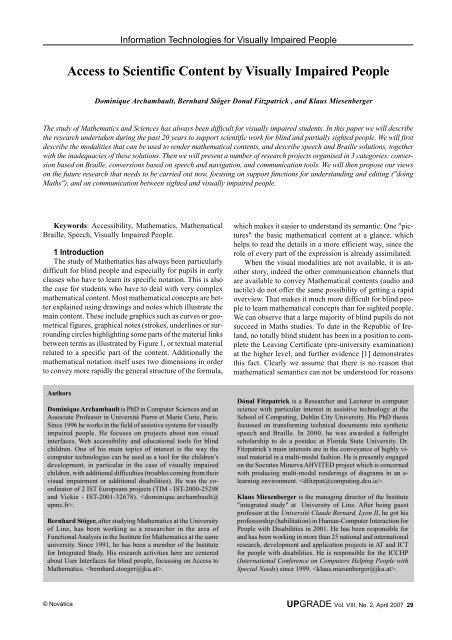Download full issue (PDF 2.1MB) - Council of European ...
Download full issue (PDF 2.1MB) - Council of European ...
Download full issue (PDF 2.1MB) - Council of European ...
Create successful ePaper yourself
Turn your PDF publications into a flip-book with our unique Google optimized e-Paper software.
© Novática<br />
Information Technologies for Visually Impaired People<br />
Access to Scientific Content by Visually Impaired People<br />
Dominique Archambault, Bernhard Stöger Donal Fitzpatrick , and Klaus Miesenberger<br />
The study <strong>of</strong> Mathematics and Sciences has always been difficult for visually impaired students. In this paper we will describe<br />
the research undertaken during the past 20 years to support scientific work for blind and partially sighted people. We will first<br />
describe the modalities that can be used to render mathematical contents, and describe speech and Braille solutions, together<br />
with the inadequacies <strong>of</strong> these solutions. Then we will present a number <strong>of</strong> research projects organised in 3 categories: conversion<br />
based on Braille, conversions based on speech and navigation, and communication tools. We will then propose our views<br />
on the future research that needs to be carried out now, focusing on support functions for understanding and editing ("doing<br />
Maths"), and on communication between sighted and visually impaired people.<br />
Keywords: Accessibility, Mathematics, Mathematical<br />
Braille, Speech, Visually Impaired People.<br />
1 Introduction<br />
The study <strong>of</strong> Mathematics has always been particularly<br />
difficult for blind people and especially for pupils in early<br />
classes who have to learn its specific notation. This is also<br />
the case for students who have to deal with very complex<br />
mathematical content. Most mathematical concepts are better<br />
explained using drawings and notes which illustrate the<br />
main content. These include graphics such as curves or geometrical<br />
figures, graphical notes (strokes, underlines or surrounding<br />
circles highlighting some parts <strong>of</strong> the material links<br />
between terms as illustrated by Figure 1, or textual material<br />
related to a specific part <strong>of</strong> the content. Additionally the<br />
mathematical notation itself uses two dimensions in order<br />
to convey more rapidly the general structure <strong>of</strong> the formula,<br />
Authors<br />
Dominique Archambault is PhD in Computer Sciences and an<br />
Associate Pr<strong>of</strong>essor in Université Pierre et Marie Curie, Paris.<br />
Since 1996 he works in the field <strong>of</strong> assistive systems for visually<br />
impaired people. He focuses on projects about non visual<br />
interfaces, Web accessibility and educational tools for blind<br />
children. One <strong>of</strong> his main topics <strong>of</strong> interest is the way the<br />
computer technologies can be used as a tool for the children’s<br />
development, in particular in the case <strong>of</strong> visually impaired<br />
children, with additional difficulties (troubles coming from their<br />
visual impairment or additional disabilities). He was the coordinator<br />
<strong>of</strong> 2 IST <strong>European</strong>s projects (TIM - IST-2000-25298<br />
and Vickie - IST-2001-32678). .<br />
Bernhard Stöger, after studying Mathematics at the University<br />
<strong>of</strong> Linz, has been working as a researcher in the area <strong>of</strong><br />
Functional Analysis in the Institute for Mathematics at the same<br />
university. Since 1991, he has been a member <strong>of</strong> the Institute<br />
for Integrated Study. His research activities here are centered<br />
about User Interfaces for blind people, focussing on Access to<br />
Mathematics. .<br />
which makes it easier to understand its semantic. One "pictures"<br />
the basic mathematical content at a glance, which<br />
helps to read the details in a more efficient way, since the<br />
role <strong>of</strong> every part <strong>of</strong> the expression is already assimilated.<br />
When the visual modalities are not available, it is another<br />
story, indeed the other communication channels that<br />
are available to convey Mathematical contents (audio and<br />
tactile) do not <strong>of</strong>fer the same possibility <strong>of</strong> getting a rapid<br />
overview. That makes it much more difficult for blind people<br />
to learn mathematical concepts than for sighted people.<br />
We can observe that a large majority <strong>of</strong> blind pupils do not<br />
succeed in Maths studies. To date in the Republic <strong>of</strong> Ireland,<br />
no totally blind student has been in a position to complete<br />
the Leaving Certificate (pre-university examination)<br />
at the higher level, and further evidence [1] demonstrates<br />
this fact. Clearly we assume that there is no reason that<br />
mathematical semantics can not be understood for reasons<br />
Dónal Fitzpatrick is a Researcher and Lecturer in computer<br />
science with particular interest in assistive technology at the<br />
School <strong>of</strong> Computing, Dublin City University. His PhD thesis<br />
focussed on transforming technical documents into synthetic<br />
speech and Braille. In 2000, he was awarded a fulbright<br />
scholarship to do a postdoc at Florida State University. Dr.<br />
Fitzpatrick’s main interests are in the conveyance <strong>of</strong> highly visual<br />
material in a multi-modal fashion. He is presently engaged<br />
on the Socrates Minerva AHVITED project which is concerned<br />
with producing multi-modal renderings <strong>of</strong> diagrams in an elearning<br />
environment. .<br />
Klaus Miesenberger is the managing director <strong>of</strong> the Institute<br />
"integrated study" at University <strong>of</strong> Linz. After being guest<br />
pr<strong>of</strong>essor at the Université Claude Bernard, Lyon II, he got his<br />
pr<strong>of</strong>essorship (habilitation) in Human-Computer Interaction for<br />
People with Disabilities in 2001. He has been responsible for<br />
and has been working in more than 25 national and international<br />
research, development and application projects in AT and ICT<br />
for people with disabilities. He is responsible for the ICCHP<br />
(International Conference on Computers Helping People with<br />
Special Needs) since 1999. .<br />
UPGRADE Vol. VIII, No. 2, April 2007 29


